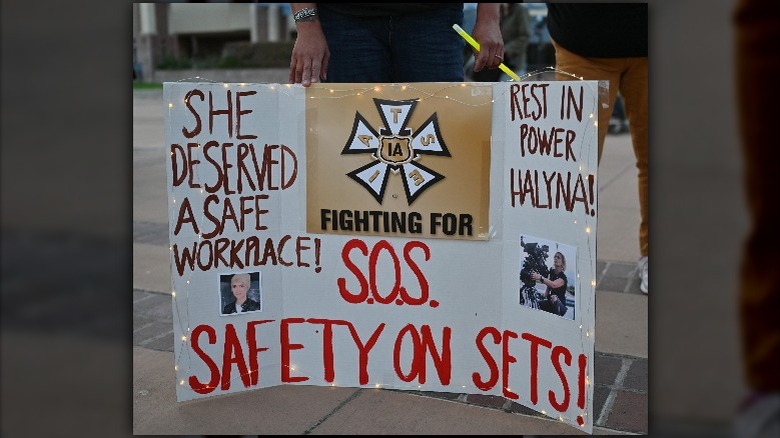New Tentative Agreement Struck Between IATSE And The AMPTP

A tentative agreement has been announced between IATSE (the International Alliance of Theatrical Stage Employees) and the AMPTP (the Alliance of Motion Picture and Television Producers) following an ongoing battle for better working conditions and safety protocol on set. The two parties have agreed to a three-year Theatrical and Television Motion Picture Area Standards Agreement deal following an earlier tentative agreement reached on October 16 for workers covered under the union's Basic Agreement that averted a major strike which would have brought the entire industry to a standstill.
Here's the difference between the Area Standards Agreement and the prior Basic Agreement. The Area Standards Agreement covers 26 locals outside Los Angeles, while the Basic Agreement covers the 13 Hollywood local unions. Together, they consist of roughly 60,000 working professionals in the film and TV industry, per Below the Line.
This new tentative deal will seemingly cover 20,000 members working outside the New York and Los Angeles areas, but would need to be approved by IATSE members by way of a vote before it can be properly implemented. IATSE announced that the previously threatened strike had been averted when it reached the deal on October 16 covering 13 West Coast Locals and around 40,000 members, with Area Standards Agreement negotiations still ongoing.
According to the union, significant gains in the current tentative Area Standards Agreement — like those in the Basic Agreement — include the following: low-wage IATSE members seeing a boost of up to 60% in hourly minimum wages, some members may receive a minimum scale wage increase of 9% by the end of their three-year contract, changes to rest periods and meal breaks, and presumably improved compensation from the streaming services.
More Questions Than Answers

While this seems to be a step in the right direction, changes are still fairly vague. According to their website, there are currently 150,000 IATSE members, and yet only a fraction of them have been factored into both tentative agreements. It's concerning that the entire membership is not being accounted for concerning these amendments — and for what reason exactly? Potentially some other deals may be established to cover the remaining IATSE membership, but then how would distribution be allocated? Presumably, location could be a factor but, again, this is a detail that has not yet been conveyed.
The proposed 60% wage increase sounds nice in theory but is not detailed in terms of how it is obtained or regulated. Furthermore, there is an obscurity about how this will be distributed and to whom. Will the increase be doled out evenly over the three-year time span or all at once? And in terms of rest periods and meal breaks, exactly how will studios and production companies be held accountable for this regulation to maintain the mental and physical health of those on set? Small fines do not seem to be making much impact, and it's no coincidence that several actors and crew members taking behind-the-scenes photos on their personal social media are largely images of them sleeping in random places on set, or appearing exhausted between scenes on long shoots.
Why Some And Not All?

IATSE international president Matthew Loeb stated:
"We were able to achieve gains in all of our core areas. Quality of life issues were at the top of our priority list. The protective terms we negotiated in this agreement and the agreement reached earlier establish a defined weekend with the studios for the first time. The two agreements incorporate stiff penalties for failing to provide meals and breaks. Taken together, the improvements we made at the bargaining table are very significant and directly due to the solidarity of our members."
Sure, but why is it that only 13% of IATSE members are being accounted for if quality of life issues are "top priority"? Why is the union seemingly settling on a temporary percentage of member coverage from the Alliance of Motion Picture and Television Producers (AMPTP)? Hopefully, questions will be answered in the upcoming weeks as members should be receiving a memorandum of agreement that will fill provide the fine print of the Basic Agreement and Area Standards Agreement tentative deals.
Change Is Long Overdue

The Area Standards Agreement reflects some major points in the Basic Agreement per pattern bargaining. Members of the West Coast Locals covered under the Basic Agreement are still receiving details of that deal. Overall, member response to the Basic Agreement has been mixed. Some have argued that after five months of member mobilization, the deal should have included longer turnaround times and higher annual scale wage increases, as well as additional improvements. Others are waiting for the full details of the agreement to render a judgment.
IATSE members include cinematographers, gaffers, writers, and makeup artists to name a few. The pandemic surfaced a large amount of poor working conditions and missing standards in order to keep these industry professionals safe, supported, and properly cared for. These calls for change have been emphasized more this past week with the tragic death of cinematographer Halyna Hutchins on the set of "Rust." News continues to unfold about the production's unsafe working conditions around handling firearms and the lack of necessary safety protocol to maintain safety.
Updates on the agreements continue to roll out over the next couple of weeks as demands seek to be met and conditions vastly improved.
Read this next: The Best Movies Of 2021 So Far
The post New Tentative Agreement Struck Between IATSE and the AMPTP appeared first on /Film.
from /Film https://ift.tt/3jIN8Oi
No comments: